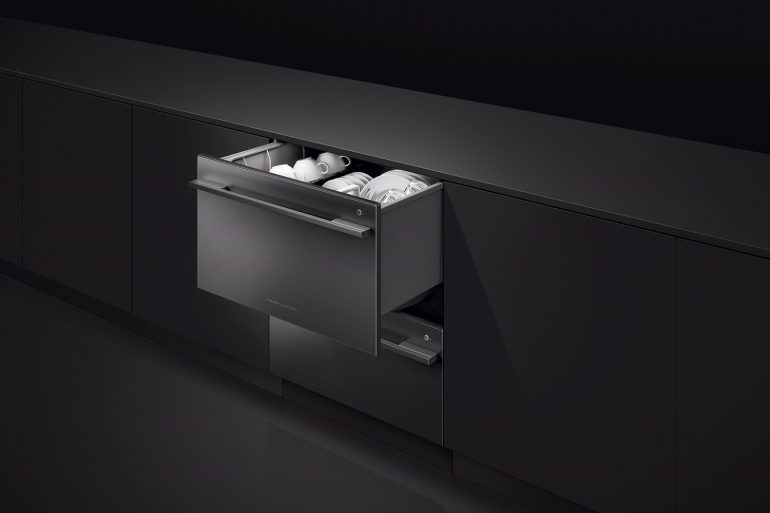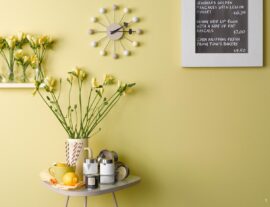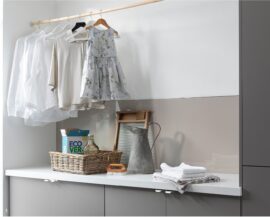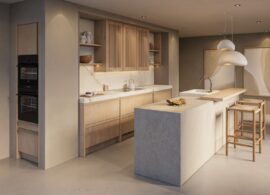Designing outside the triangle
Mark Elmore, General Manager, Design at FISHER & PAYKEL talks about design in the kitchen and explains why the so called ‘kitchen triangle’ is redundant.
Mark has been designing kitchen appliances for decades. He is particularly interested in the physical and architectural changes that have occurred, and in the sociological and psychological ways in which kitchens have changed over the years.
The so-called kitchen triangle is now redundant. Gone are the days when work in the kitchen was seen as a chore to be done as efficiently as possible, usually by only one person. The kitchen has become our studio for creating and socialising – it’s the social hub.
The changing nature of today’s kitchen provides designers with opportunities to innovate and develop multiple right answers — after all, there is not one size that fits all.
In today’s kitchen we create, we experiment: the kitchen is now our metaphorical ‘shed’ where we tinker, perhaps making it up as we go along, perhaps following a recipe. Today’s kitchen is multifunction room and a place used to communicate our social status. It is a place where cooking is a collaborative act.
Distribution Appliances:
This means not only that kitchens are growing bigger but also that we have to rethink the concept of the working triangle. As appliance manufacturers, we have had a look at what we can do to respond to these trends. We have started to separate the components.
Now it is possible to have a CoolDrawer™ Multi-temperature Drawer for drinks by the dining table, perhaps a DishDrawer™ Dishwasher for crockery by the sink and one for glasses by the bar. We also need to consider: where do we want the vegetables, where do we want the utensils, where do we want the freezer?
As kitchens evolve to be more like lounge spaces, the technology is becoming more embedded. Kitchen cabinets are looking more like furniture placed in the centre of a room and we have made sure that our appliances integrate seamlessly.

Domestic appliances are required to be multidisciplinary, not only performing multiple functions but also working with different people with differing skills.
The design challenge: flexibility
The range of things we cook in the kitchen has changed: sometimes we just want to heat up some leftovers or takeaways; other times we want to create gastronomic feasts to impress others. This range of cooking, from fast food to slow food and back again, affects the way in which we must design kitchens and the appliances that go in them.
There is also a trend towards more fresh-food cooking but often this is paradoxical, as the interest in locally grown, organically grown foods increases, so does the interest in international foods. Our palates are much more global; we eat foods from around the world, cooked in authentic utensils with authentic ingredients. This paradoxical situation provides designers with opportunities to be creative in providing bespoke design solutions. We are also eating more healthily—or at least trying to do so. This will have an impact on how we design spaces for different foodstuffs to take into account their requirements for storage, handling and preparation.
Design trends have brought elements of the professional kitchen into the domestic kitchen but some of the design parameters can be quite different. The professional kitchen is often simple, built around reliability and efficiency of use, whereas the domestic kitchen has to be quite flexible, doing many things well.
Design Freedom
In the professional kitchen it is the chef that is the master, whereas in the home kitchen the technology sometimes has to work harder to make us look good. The amateur at home can have little knowledge and, with more children engaging with food, health and diet, the technology needs to be simple, obvious and suitable for small, large and elderly hands. It’s not just about physical ergonomics but also about cognitive ergonomics; it’s about how appliances make us feel.
Domestic appliances are required to be multidisciplinary, not only performing multiple functions but also working with different people with differing skills. But we still want the same levels of control and precision. The appliances don’t have the rigour or scale of working of the professional items, but they must be intuitive to use and have the capacity to flex and improvise.
Why the triangle is obsolete
The concept of the ‘work triangle’ in kitchen design was based on working between the key components of the hob/oven, the fridge and the sink. It came from an efficient time-and-motion study—based on a production-line metaphor. Work in the kitchen was seen as a chore to be done as efficiently as possible, usually by only one person. In today’s kitchen we create, we experiment. In some countries we understand there are even ‘personal trainers’ who will come in and work with the cooks. And instead of just sitting there and watching the theatre unfold, the visitor is picking up the cooking utensils and joining in. Work in the kitchen is now a team effort.





